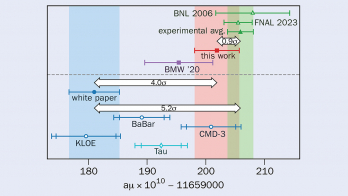By T Padmanabhan
Cambridge University Press
Hardback: £50 $85
E-book: $68

The general theory of relativity – the foundation of gravitation and cosmology – may be as widely known today as Newton’s laws were before Einstein proposed their geometric interpretation. That was around 100 years ago, yet many unanswered questions and issues are being revisited from the current perspective, such as: why is gravity described by geometry and why is the cosmological constant so extraordinarily fine-tuned in comparison with the scale of elementary particles?
In an active research field – where the universe at large meets the discoveries in particle physics – there is much need for textbooks based on research that address gravity in depth. Thanu Padmanabhan’s book fills this need well and in a unique way. Within minutes of opening the rich, heavy, full, yet succinctly written 728 pages I realized that this is a new and personal view on general relativity, which leads beyond many excellent standard textbooks and offers a challenging training ground for students with its original exercises and study topics.
In the first 340 pages, the book presents the fundamentals of relativity in an approachable style. Yet, even in this “standard” part the text goes far beyond the conventional framework in preparing the reader in depth for mastering the “frontiers”. The titles of the following chapters speak for themselves: “Black Holes”, “Gravitational Waves”, “Relativistic Cosmology” and “Evolution of Cosmological Perturbations”, all of which address key domains in present-day research. Then, on page 591, the book turns to the quantum frontier and extensions of general relativity to extra dimensions, and to efforts to view it as an effective “emergent” theory.
This research-oriented volume is written in a format that is suitable for a primary text in a year-long graduate class on general relativity, although the lecturer is likely to leave a few of the chapters to self-study. “Padmanabhan” complements the somewhat older offerings of this type, such as “The Big Black Book” (Gravitation by Charles Misner, Kip Thorne and John Wheeler, W H Freeman 1973) or “Weinberg” (Gravitation and Cosmology: Principles and Applications of the General Theory of Relativity, Wiley 1972).
Naturally, this publication differs greatly from “text and no research” offerings, such as Ta-Pei Cheng’s Relativity, Gravitation and Cosmology: A Basic Introduction (OUP 2009) or Ray d’Inverno’s Introducing Einstein’s Relativity (OUP 1992). Any lecturer using these should consider adding “Padmanabhan” as an optional text to offer a wider view to students on what is happening in research today. In comparison with “Hartle” (Gravity: An Introduction to Einstein’s General Relativity, Addison-Wesley 2003), one cannot but admire that “Padmanabhan” does not send the reader to other texts to handle details of computations; what is mentioned is also derived and explained in depth. Of course, “Hartle” is often used in a “first” course on gravity but frankly how often is there a “second” course?
“Padmanabhan” is, as noted earlier, voluminous, making it an excellent value for money because it contains the material of three contemporary books for the price of one. So who should own a copy? Certainly for any good library covering physics, the question is really not if to buy but how many copies. I also highly recommend it to anyone interested in general relativity and related fields because it offers a modern update. Students who have already had a “first” course in the subject and are considering taking up research in this field will find in “Padmanabhan” a self-study text to deepen their understanding. If you are a bookworm like me, you must have it, because it is a great read from start to finish.







